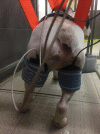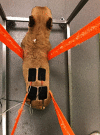Nervous system modulation through electrical stimulation in companion animals
- PMID: 34053462
- PMCID: PMC8167506
- DOI: 10.1186/s13028-021-00585-z
Nervous system modulation through electrical stimulation in companion animals
Erratum in
-
Correction to: Nervous system modulation through electrical stimulation in companion animals.Acta Vet Scand. 2021 Aug 24;63(1):31. doi: 10.1186/s13028-021-00594-y. Acta Vet Scand. 2021. PMID: 34429145 Free PMC article. No abstract available.
Abstract
Domestic animals with severe spontaneous spinal cord injury (SCI), including dogs and cats that are deep pain perception negative (DPP-), can benefit from specific evaluations involving neurorehabilitation integrative protocols. In human medicine, patients without deep pain sensation, classified as grade A on the American Spinal Injury Association (ASIA) impairment scale, can recover after multidisciplinary approaches that include rehabilitation modalities, such as functional electrical stimulation (FES), transcutaneous electrical spinal cord stimulation (TESCS) and transcranial direct current stimulation (TDCS). This review intends to explore the history, biophysics, neurophysiology, neuroanatomy and the parameters of FES, TESCS, and TDCS, as safe and noninvasive rehabilitation modalities applied in the veterinary field. Additional studies need to be conducted in clinical settings to successfully implement these guidelines in dogs and cats.
Keywords: Cat; Dog; Electrostimulation; Functionality; Neurorehabilitation modalities; Spinal cord.
Conflict of interest statement
The authors declare that they have no competing interests.
Figures






References
-
- Dobkin BH, Apple D, Barbeau H, Basso M, Behrman A, Deforge D, et al. Methods for a randomized trial of weight-supported treadmill training versus conventional training for walking during inpatient rehabilitation after incomplete traumatic spinal cord injury. Neurorehabil Neural Repair. 2003;17:153–67. - PMC - PubMed
-
- Thomson C, Hahn C. Reflexes and motor systems. In: Thomson C, Hahn C, editors. Veterinary neuroanatomy: a clinical approach. Edinburgh: Elsevier; 2012. pp. 47–57.
Publication types
MeSH terms
LinkOut - more resources
Full Text Sources
Other Literature Sources
Medical
Miscellaneous

